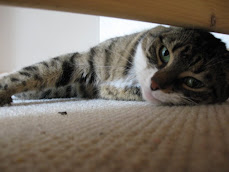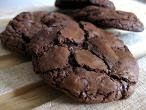
Anyway, this is a dessert I made a couple of weeks ago after finally spying some quince in a local greengrocer. I've been intrigued by quince since reading Nigella Lawson's How to be a Domestic Goddess, where she features it in several recipes. It's a quintessentially English orchard type of fruit and yet I have never previously seen it in the shops, despite looking. I snapped up two and gleefully brought them home with no particular idea as to what to do with them. They are hard, yellow fruits that look a lot like apples (and are related to them) but I don't believe that you would want to try biting into a raw one - not if you didn't want to spend the rest of the evening with your lips puckered inside your mouth. They have a long and illustrious history, however, being a symbol of fertility (what isn't?), associated with Aphrodite, and possibly even the fruit that Eve ate in the Garden of Eden. David Lebowitz says that they smell so nice that he likes to leave them in his kitchen overnight just for the fragrance. When I read that I went and sniffed ours, but they didn't seem to have an especially noticeable smell.

A week or so later, kitchen still unfragranced, I decided I should do something with them. I wanted something light, so I settled on a simple poached recipe. David Lebowitz has a couple, one of which particularly appealed because it used a vanilla syrup - one of my favourite flavours. I read all his instructions on how to peel these rather hard and knobbly fruits and set to work prepared for a battle. Alas, I had left my quinces a bit too long, and they were quite soft and dark in places when I cut into them. I had to cut so much off that I was only left with a small pile for poaching. I didn't want to give up, so I remembered the gingery poached dried apricots I made a while ago, and so added some dried apricots to my quince.

I was glad I'd stuck with it, as it made a lovely dessert. The quince was nice and soft, but I particularly liked the contrast between it and the chewier apricots. The syrup was very sweet - you could easily cut back on the sugar if you didn't have too sweet a tooth, or were making it for a breakfast compote, but the vanilla flavour was divine. This will be on the list for the next time I stumble upon a quince - whenever that is. Funnily enough though, I also found another ingredient I've been searching for for years this week - samphire. My PhD supervisor's wife used to cook it for their summer parties, but I have never found it anywhere. I finally found it at Borough Market last weekend and brought some back. I just steamed it lightly and ate it atop a poached egg on an English muffin. It was salty and yummy. I wish I'd bought more.
Vanilla poached quince recipe here (and I can recommend adding a few dried apricots too)



3 comments:
you have just got me running to my how to be a domestic goddess for quince ideas - I have some quinces my mum poached, some quinces in syrup and some quince paste in my house and it needs to be used - so thanks for the idea! Quince and apricots sounds excellent.
Maggie Beer (an Australian cookery book writer) says that quinces are quite similar to apples so can be substituted in apple recipes - my mum used to make quince jelly which I loved - but I must soon post about a quince cake I made ages ago. And I must check with my mum about baked quince she did last year which was beautiful
Quince cake sounds lovely - now I just need to wait to find more quinces! I also bought some quince paste once after discovering I liked manchego cheese - a lovely combination.
Lovely photographs.
To really experience the fragrance of a quince you need to pick them fresh from the bush - take a look around your neighbour's gardens, it's surprising how many of them have quince bushes as ornamental shrubs.
Post a Comment